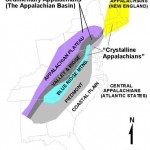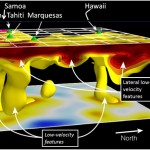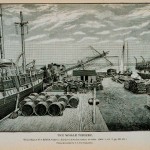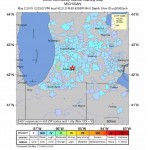This post is from my notes for the first week of lecture in Wheels of Metals: Urban Mining for a Circular Economy on Coursera, and it highlights—for common metals (iron, copper, aluminum)—useful properties that makes the metal attractive for applications, what applications the metal is used in, where and how the metal is mined, how the metal is processed, and how it is recycled.
Iron
Mixed metals. Image credit: nde-ed.org
Useful Properties
- Malleable, soft
- Strong with the addition of carbon (to form steel)
Uses
- 98% as steel: Fe + <2% C
- Pig iron: >2% iron, becomes brittle
- 11-16 tons steel per capita
- Most steel in buildings, infrastructure
Mining
- Large-scale open pits
- China: 44%
- Australia: 18%
- Brazil: 13%
- Transported by ship and railway
Processing
- Iron oxide ores converted to pure iron by reducing iron oxide by heating and oxygenating
- Heated with coke (coal-derived carbon-rich fuel)
- Oxygen steel making: pure oxygen blown over hot ore to produce low carbon steel
- Electric arc furnace: scrap metal and pig iron heated together to produce low carbon steal
- Add up to 50% other elements for specialty steel: up to 30% Cr in stainless steel, with Ni, Mn; rare earth elements add heat resistance
Recycling
- Most iron still in active use
- Collected from demolished buildings
- Easily collected from landfills with magnets
Copper
Useful Properties
- Very high conductivity
- More readily available than other good conductors like silver
- Doesn't form oxides, which will spark, as readily as aluminum, so preferable inside buildings
- Biostatic, preventing bacterial growth
- Very strong with the addition of tin (to form bronze)
Uses
- Electric wiring: 60%
- Plumbing: 20%
- Industrial machines: 15%
Mining
- Mostly open pits (75%), some underground mines (25%)
- Chile: 32%
- China: 9%
- Peru + US: 7%
Processing
- 50% from chalcopyrite ores (CuFeS2)
- Low Cu concentration in ore (25-35%)
- Grind ore, then refine
- Pyrometallurgical for sulfide ores: oxidation at high temperatures via smelting, then analytic refining
- Hydrometallurgical for oxide ores: leaching to generate copper ions, extraction via electrowinning, conversion into pure copper by electrolysis
Recycling
- Most copper still in active use
- Used in applications that makes accessibility, recovery easy
- Eddy current separators
- Common target of theft
Aluminum
Useful Properties
- High conductivity
- Very lightweight, but strong
- Most abundant metal in crust
Uses
- Transportation
- Construction (outer shells of buildings)
- Overhead power lines
Mining
- Bauxite contains 40-60% aluminum oxide
- Large-scale open pits
- Purified on site, transported to refinery
- Waste product: red mud
Processing
- Requires plentiful electricity
- Electrolysis reduces oxide to create pure aluminum
Recycling
- Most still in use
- Used in applications where easy to recover
- Eddy current separators
Rare Earth Elements
Properties
- 17 elements of very similar chemical and physical properties
- Called "rare" because before special technology was developed, similar properties meant individual REEs could not be separated
Uses
- Energy-efficient light bulbs
- Magnets
- Electric motors & wind turbines
Mining
- Large-scale open pits
- China: 90%
- By-product of iron mining, clay minerals
- China: 90%
Processing
- Concentrated via acid roasting and leaching
- Separated via solvent extraction into metal oxides for transport
- Oxides reduced onsite via electrolysis to create pure metals
Recycling
- Low recycling rate due to difficulty of recovery
- Technology improving






